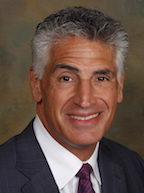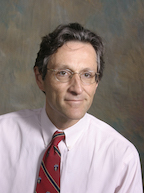Expanding Treatment Options for Aortic Aneurysms
 Advances in the treatment of complex aortic aneurysms — especially novel endovascular devices and hybrid procedures
Advances in the treatment of complex aortic aneurysms — especially novel endovascular devices and hybrid procedures
— make it possible to choose the right procedure for the right patient at the right time to minimize risk and maximize long-term benefit, says Michael Conte, M.D., chief of the Division of Vascular and Endovascular Surgery at UCSF Medical Center.
"We still perform a significant volume of open repair for complex aneurysms," Conte says. "But we're also one of only two or three centers in the country with deep experience in the use of branched stent grafts."
A leading academic medical center like UCSF draws on interdisciplinary teams with a unique breadth of expertise to confidently offer treatments to make those choices and, often, offer treatment to patients who may not be deemed candidates in other centers.
Branched Stent Grafts
The UCSF team — which recently completed its 100th stent graft procedure for thoracoabdominal aneurysms — selects patients for all branched stent graft procedures based on three criteria:
- The risks of alternative strategies.
- The ability of the patient to withstand conventional surgery.
- The feasibility of using endovascular techniques.
 "We've found that the vast majority of people sent to us to be assessed — for whom alternative procedures, including conventional surgery, are not appropriate — can be treated by endovascular means," says vascular surgeon Timothy Chuter, M.D., a pioneer in the design and use of branched and fenestrated stent grafts.
"We've found that the vast majority of people sent to us to be assessed — for whom alternative procedures, including conventional surgery, are not appropriate — can be treated by endovascular means," says vascular surgeon Timothy Chuter, M.D., a pioneer in the design and use of branched and fenestrated stent grafts.
He notes that a decade of experience has also meant that rather than having patients undergo risky waits for the branched stent grafts, surgeons today can often piece together "off-the-shelf" components and tailor them to the patient's anatomy during the procedure.
Open and Hybrid Surgeries
 Despite these advances, open surgery for aortic arch aneurysms remains the gold standard for most patients, says Scot Merrick, M.D., chief of the Division of Adult Cardiothoracic Surgery. These days such procedures typically involve cannulating a vessel to provide collateral blood flow to the brain and lower body, thus averting the need for total circulatory arrest.
Despite these advances, open surgery for aortic arch aneurysms remains the gold standard for most patients, says Scot Merrick, M.D., chief of the Division of Adult Cardiothoracic Surgery. These days such procedures typically involve cannulating a vessel to provide collateral blood flow to the brain and lower body, thus averting the need for total circulatory arrest.
But when patients are not candidates for an open procedure, Merrick notes he has worked with vascular surgeons to complete hybrid operations using the branched stent grafts. "Patient selection is the key," says Merrick. "The beauty of UCSF is that we are used to making multidisciplinary decisions on how to manage these patients."
Acute Aortic Dissection
Innovations in stent technology
For acute aortic dissection, this flexible multidisciplinary approach combines with assessment and 3-D imaging to facilitate triage to the most appropriate service.
 "When dissection requires immediate surgery by the cardiac and vascular team, we have established a dedicated transfer bed for these patients that guarantees prompt repair," says Conte. "If blood flow to organs is not compromised and there is no impending rupture, dissections not involving the ascending aorta can be treated medically and with close patient monitoring."
"When dissection requires immediate surgery by the cardiac and vascular team, we have established a dedicated transfer bed for these patients that guarantees prompt repair," says Conte. "If blood flow to organs is not compromised and there is no impending rupture, dissections not involving the ascending aorta can be treated medically and with close patient monitoring."
"However, if there are complications requiring urgent treatment, we usually use an endovascular graft to seal off the dissection and stents to maintain blood flow in critical arteries," says Chuter. Depending on the need, teams might also use a combination of open surgical and endovascular techniques.